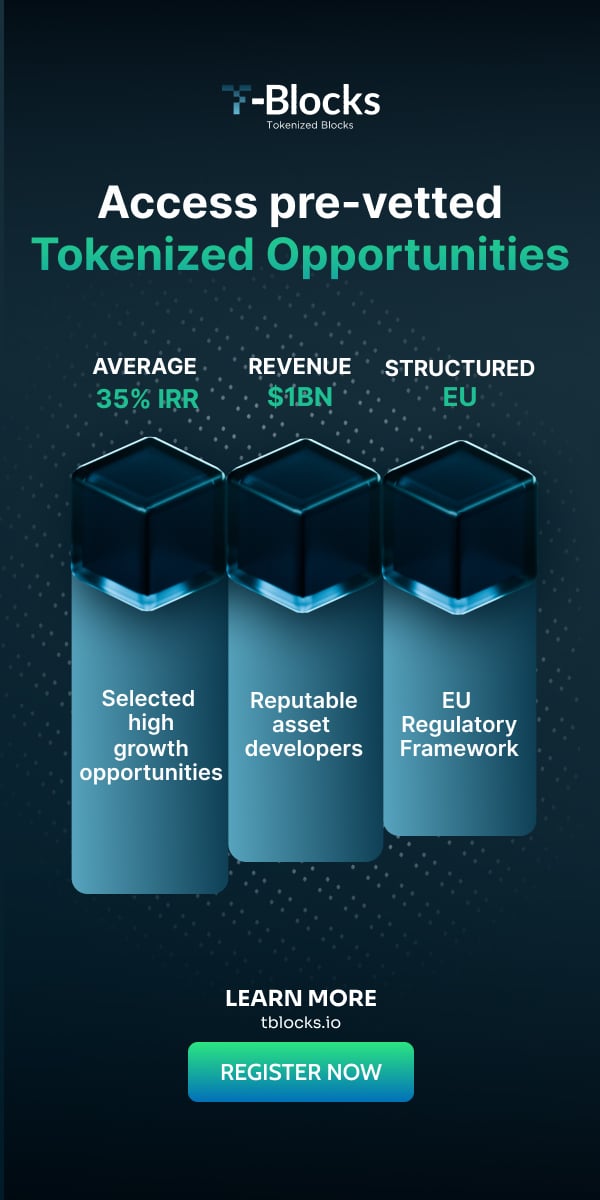How asset tokenisation can be used to advance climate initiatives
There are challenging issues looming with green and sustainability-linked finance and investments. It is difficult to connect real-world evidence of the benefits of funding to transparent, accessible, and authentic data. Asset tokenisation could be employed to assist – tokenization is flexible, adaptable, and automated, making it a useful solution for achieving climate-related goals. What is asset tokenization?
By Bryony Widdup, Partner, Hogan Lovells
Asset tokenization is a process whereby a typically illiquid asset is converted into digital assets – distributed ledger technology (DLT)-based tokens which have a fractional value of the original asset, issued with rights in respect of that asset.
Commercial property is a good example. Just as there are a number of ways to own interests in a property, there are a number of ways to create tokens by reference to property interests. Currently, fractionalization in property is limited. The basic underlying freehold unit of the property, at that level, cannot be subdivided without interaction with the land registry. While land registries are advancing with digital, this type of interactivity is a long way off. So, a freehold may be held in a vehicle or trust in order for interests to be unitized for investors via digital tokens. The tokens reference an indirect interest in the property via the vehicle. This might be a propco-type arrangement or a fund, with a portfolio of assets underlying.
Alternatively, contract-based interests can be made available. If it is let, a landlord can grant interests in income from the property. Interest in debt secured on the property can also be created, including by direct lending – for example, when combined with a share in the benefit of relevant security via a trust, or via sub-participation granted by a lender. There are a number of examples in the market beyond real estate – this process can be applied to works of art, expensive machinery or vehicles. There is an ever-expanding list of possibilities.

One main benefit of tokenizing assets is that it increases their liquidity, allowing the tokens to be traded on appropriate secondary markets. Fractionalization means investors can also purchase tokens that represent very small percentages of the underlying assets, making investing much more accessible. The smart contract automation underlying the tokens can make administration, trading, and operations much more efficient, with disintermediation reducing fee burden.
What does all this have to do with climate goals?
Compared to traditional ownership methods, asset tokenization provides a much more stringent, direct way to integrate environmental performance targets and reporting into assets, supporting the monitoring, reporting and verification (MPV) aspects of climate-related projects. In addition, because tokens are fractional interests, and the right to data can be associated with a very small holding, data accessibility inefficiencies that we might see in traditional markets are eliminated. Everyone who owns a token can have data rights associated with that token, as well as the economic rights such as capital, interest and income.
The drawback of fractionalization is influence. On the one hand, as we know from observing governance dynamics in large cap, broadly held listed companies, there is a lack of influence over corporate behaviour in the absence of strategic shareholder action (eg via activist shareholder groups and funds).
On the other hand, large single counterparties, such as significant secured lenders, do have influence. This may be through their contracts under covenants and enforcement rights on default, or their relationships with the business (including senior executives) and the extent of dependence of the business on such counterparties. In theory, a fractionalized holding system would allow activist groups and public opinion to take on some power of influence. However, this is more likely to be expressed in a negative way (demands for cessation of activities, removal of the CEO, or similar) rather than more positive influence that can come through long-standing, trusted relationships. This is a challenge that should be explored further as tokenization becomes more prevalent. There are also some well-publicised energy consumption challenges associated with some of the blockchains that underpin token issuance. We do not have time to go into that in detail here, but not all blockchains are equivalently inefficient and there is increasing focus on developing the types of energy efficiencies we will need for these technologies to thrive in a sustainable future.
Having acknowledged some drawbacks, we will now look at two case studies: first, the application of asset tokenization in a sustainability-linked loan context; and second, a climate technology asset improvement scenario. As a result of the multiple useful features of tokenization, the potential for use in climate-related project funding is vast. That said, it is relatively unexplored. These two case studies are provided as “seed” scenarios, on which we would hope many more applications can be built.
Sustainability-linked “debt” type arrangement
One example of where tokenization would bring advancement to climate initiatives is through sustainability-linked loans. These work by importing key performance indicators (KPIs) from the asset and its surrounding ownership context into the loan. Then there is a margin variation (interest increase/decrease) associated with meeting or failing to meet the applicable targets.
We can envisage a transaction where efficiencies are vastly improved by the borrower issuing asset tokens that are bought by funders, instead of raising a loan in the traditional way. Assume the loan is a traditional secured loan. It contains sustainability-linked covenants, together with associated manual reporting of the KPIs from the borrower, via the sustainability auditor, to the lenders (in respect of financials, this would generally be borrower/its accountants to the lender). The lender reviews, considers reporting to monitor KPI performance, and takes action in respect of defaults accordingly.
Instead of borrowing a secured loan, a fractionalized asset token can be issued to provide rights to periodic payments arising from the income generated by that asset (ie interest). This interest would vary in amount based on certain data inputs, the right to a redemption sum at a future date (ie capital repayment), and the right to take control of the asset, including for purposes of liquidation, if certain covenants have been breached (this is likely granted to a trustee or similar party on behalf of the asset token-holder). Frequently, the security we implement in a regular finance transaction is based on an absolute assignment, with a proviso for reassignment on the redemption of the underlying liability. This structure would similarly provide for the trustee, receiver, or third-party service provider to manage the tokenized asset ownership and protect the token-holders’ interests.
If the tokens create something so similar to the existing standard arrangements, you might wonder why tokenization is necessary. And the answer is that tokenization really begins to differentiate in the area of data input, monitoring, and reporting on all aspects of the funding. Smart contract automation incorporated into tokens can accommodate automated actions on the back of oracle and manual data inputs. Data inputs on science-based pathways and targets, combined with real-time evidence obtained through oracles, from carbon emission monitors, accountant recording systems, public registries and more, can automatically be linked to the token.
If we take a simple carbon emission KPI, a science-based pathway may provide for a target outcome on the reduction of carbon emissions in a specific period of time. With a token, this target can easily be adjusted based on updated science-based inputs over time. Then a carbon emission monitor can report in real-time into the token on whether or not the KPI is being met. It may be that this whole data piece remains as information only (ie does not have financial consequences for the asset owner/token-holders) until an external auditor has reviewed and verified the data. However, upon that oracle data point being satisfied, the return on the token can be directly adjusted in line with the reported result. There is no further reporting, monitoring, or checking, and there is considerably less delay between action and impact.
Furthermore, there are key ethical considerations around what to do with the sustainability-linked “upside” for funders as a result of these transactions. It is not appropriate in many cases for funders to benefit from increased returns where the funded asset is failing to achieve relevant targets or goals. Another benefit of tokenization is the ability to sub-divide ownership fractions so a relevant charitable organization, carbon innovation fund, or similar appropriate beneficiary, can take the interest in any “upside” in a “special benefit” token, which distributes the relevant value to the extent that this is being paid out in a straightforward and fully transparent manner.
Asset investment in climate-related tech improvement
In an asset investment scenario, the owner may want to raise funds for development or acquisition of climate emission improvement technology for the asset. For example, they may be looking to develop a carbon capture kit for energy assets, which would improve net zero performance, reduce the need to rely on offsetting, and may one day produce its own income streams through application in industries such as concrete production, farming or perhaps even in synthetic diamond production.
Tokenization can provide benefits for funders in this project such as purpose monitoring, automated milestone reporting, evidencing outcomes and improvements, and creating a link to financial benefit. For example, an automatic allocation of savings on offsets can be made to the token-holding investors, and profit sharing in fee streams that may ultimately arise from circularity within repurposing of carbon could also be linked in. This begins to take on material relevance in the context of repurposing carbon captured into high-value industrial use cases such as diamond production. The ability to create the link to future income streams via smart contracts is likely to be highly attractive to the up-front funders.
As with all aspects of digital assets, there may be taxonomy and regulatory perimeter complexities with this type of pursuit. Some of the ways in which this can be achieved may result in securities token issuance, for example. But in a number of respects, that doesn’t really matter. The benefits associated with tokenizing assets for the delivery of climate-related goals are still available if this can be integrated up front.
Tokenization offers data integration (including oracle sourcing), automation, and real-time functionality, together with the potential fractionalization and disintermediation advantages. This makes it a tool that is highly suited for achieving climate-related goals. Integrating this with a token-based, voluntary carbon trading or carbon offset system (reflecting realistic carbon pricing) would look a lot like progress. We may have to wait a while to see this in action, but fintech as an industry is core to advancing climate initiatives by getting this up and running and fully integrated into global financial markets.
Photo by Melissa Bradley on Unsplash
Read other stories: Securitize Launches Fund Providing Tokenized Exposure to KKR Fund for the First Time in the U.S





















